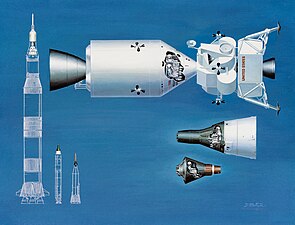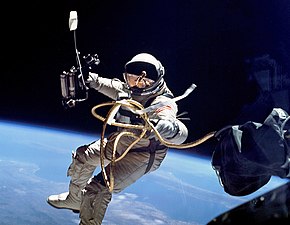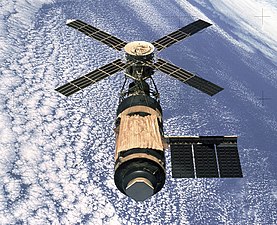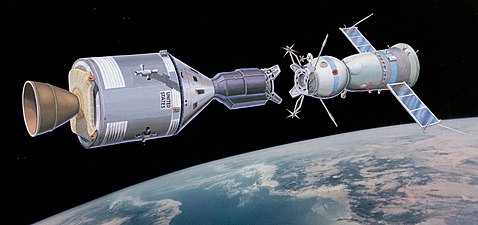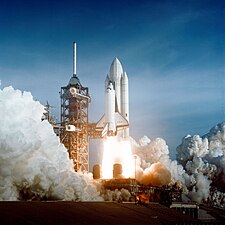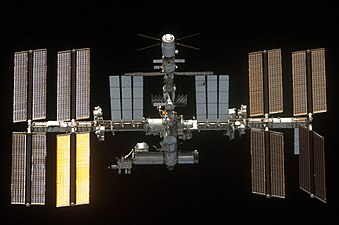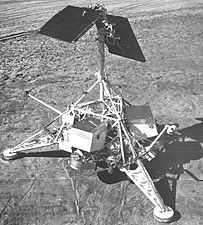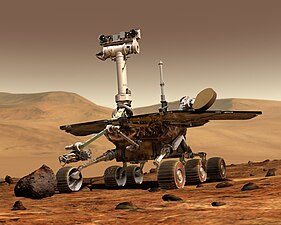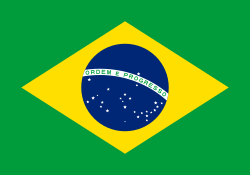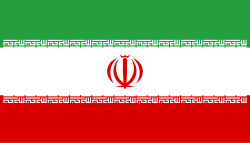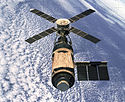NASA
| National Aeronautics and Space Administration NASA | |
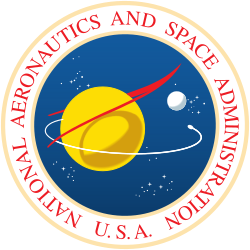 Officiellt sigill | |
| Underordnad | USA:s president[1] |
|---|---|
| Departement | Fristående myndighet[1] |
| Ledning | Administratören utses av presidenten med senatens råd och samtycke.[1][2] |
| Säte | 300 E Street SW, Washington, D.C.[1] |
| Överordnad | 20 anläggningar och forskningscentra[3] |
| Syfte | Civil rymdfart och aeronautisk forskning |
| Föregångare | National Advisory Committee for Aeronautics[1] |
| Inrättad | 1958[1] |
| Budget | 23,2 miljarder USD[3] |
| Antal anställda | 18 000 federalt anställda[3] |
| Webbplats | www.nasa.gov |
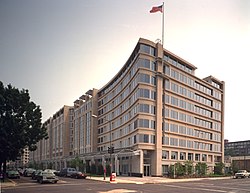

National Aeronautics and Space Administration (NASA) är USA:s fristående myndighet för rymdfart och rymdforskning.
NASA grundades 1958 som en direkt följd av Sovjetunionens uppskjutning av Sputnik 1.
Historia
Efter att Sovjetunionen skickat upp världens första artificiella satellit började den amerikanska kongressen och president Dwight D. Eisenhower arbeta fram en ny federal myndighet som skulle skapas för att ta hand om alla rymdaktiviteter. Den 29 juli 1958 skrev Eisenhower på National Aeronautics and Space Act of 1958 och därmed var Nasa bildat. Från början var det bara fyra laboratorier och omkring 8 000 anställda som tidigare arbetat för NACA, USA:s gamla aeronautiska myndighet. Det uppstod en rymdkapplöpning mellan Sovjetunionen och USA, vars relationer redan var anspända på grund av kalla kriget. Nasas första uppdrag var att forska och utveckla bemannade rymdfärder genom Mercuryprogrammet.
Bemannade program
Mercuryprogrammet
Mercuryprogrammet var Nasas första lyckade bemannade rymdprogram. Det höll på från 1959 till 1963 och det skickades upp totalt 20 kapslar. Målet var i första hand att ta reda på om människor kunde överleva i rymden. Kapslarna var mycket små, endast 1,7 kubikmeter och det var knappt att en person fick plats i dem.
Geminiprogrammet
Geminiprogrammet var Nasas andra rymdprogram och höll på från 1963 till 1966. Den var en fortsättning på Mercuryprogrammet och hade som mål att förbereda inför Apolloprogrammet genom att utveckla dockningsmöjligheter och andra tekniker som behövdes för att landa på månen. Det gjordes tolv uppskjutningar varav tio var bemannande.
Apolloprogrammet
Apolloprogrammet var från början tänkt att skicka människor nära månen men efter president John F. Kennedys uttalande om att han tänkte sätta människor på månen innan 1970 ändrades inriktningen till att landa på månen. Den första tänkta färden i Apolloprogrammet var Apollo 1, men den slutade i tragedi. Alla tre ombord omkom i en brand i kapseln. Från 1961 till 1972 gjordes det 33 uppskjutningar. Apollo 11 var det första uppdraget att landa på månen.[4] Inom detta program utvecklades också den största raket som någonsin byggts, nämligen Saturn V.
Skylab
Skylab var NASA:s första rymdstation och låg i bana runt jorden mellan 14 maj 1973 och 11 juli 1979 och var bemannad i totalt 171 dagar och 13 timmar av tre olika tremannalag.[5]
Apollo-Sojuz-testprojektet
Apollo-Sojuz-testprojektet var ett samarbete mellan USA och Sovjetunionen under första halvan av 1970-talet. Höjdpunkten var dockning mellan en Apollo-farkost och en Sojuz-farkost i omloppsbana runt jorden, i juli 1975.[6][7]
Rymdfärjor
Rymdfärjor börjades utvecklas i slutet av 1960-talet och rymdfärjeprogrammet (STS Space Shuttle) avslutades 2011. Första uppskjutningen gjordes i april 1981 och den sista i juli 2011, totalt 135 uppskjutningar.[8] 1986 havererade rymdfärjan Challenger och 2003 havererade Columbia.[9] De tre kvarvarande färjorna, Discovery, Atlantis och Endeavour är nu "pensionerade" och tillsammans med flera fullskaliga modeller som användes under utvecklingen av rymdfärjan, finns de numera att beskåda på flera olika amerikanska museer.
International Space Station
International Space Station, ISS, är en rymdstation som gjorts av sex rymdstyrelser tillsammans: USA, Ryssland, Kanada, Japan, Brasilien och ESA. ISS första modul skickades upp 20 november 1998.[10]
MPCV
Denna är tänkt som ersättare till rymdfärjorna. Projektet presenterades av NASA den 24 maj 2011. MPCV är sprungen ur Constellationprogrammets kapsel – Orion.[11]
Constellationprogrammet var Nasas projekt som skulle ha gett USA ett nytt framtida bemannat rymdflygningsprogram för att ersätta rymdfärjorna då dessa skulle tas ur bruk. I och med president Obamas budget för FY2011, som presenterades den 1 februari 2010, upphörde finansieringen av utvecklandet av raketer, kapsel och månlandare. President Obamas plan var att de amerikanska astronauterna skulle "lifta" med ryska Sojuz-kapslar till ISS. Den 3 april 2014 kom ett memo ut som uppgav att samarbetet mellan NASA och Ryssland bröts, med undantag för ISS. Detta är en i raden av de sanktioner som USA riktat mot Ryssland gällande annekteringen av Krim-halvön. NASA har nu börjat se över kommersiella alternativ för att transportera astronauter, med början år 2017.
Obemannade projekt
Färder till månen
Pioneerprogrammet
Det första Nasa ville nå var månen, men man hade problem med de första sonderna. I augusti 1958 exploderade Pioneer 0 efter bara 77 sekunders färd. I oktober samma år störtade Pioneer 1 i Stilla havet. I november misslyckades man med uppskjutningen av Pioneer 2, och i december 1958 föll Pioneer 3 ner mot jorden igen i Centralamerika. Dessa sonder var väldigt lätta jämfört med andra sonder; Pioneer 4 vägde bara sex kilo. Pioneer 4 var också den första sonden att nå månen (ett avstånd på 348 000 km), men av oförklarliga skäl fungerade inte bildöverföringen.
Rangerprogrammet
Rangerfarkosterna var mycket mer avancerade än de föregående amerikanska sonderna. Syftet med rangersonderna var att en liten kapsel skulle kraschlanda på månens yta. Dessa "självmordsonder" var utrustade med en kamera som skulle filma tills den krossades av nedslaget. Från den sista Rangersonden, Ranger 9 kunde man se detaljer ned till 30 centimeter i diameter.
Surveyorprogrammet
Surveyorprogrammet var USA:s första program för att landa en sond på månen. Den första landaren nådde ytan i maj 1966. När farkosten närmade sig månens yta efter 63 timmars färd slogs fyra små raketer på tills den stod i det närmaste stilla fyra meter över ytan, varefter den fick falla fritt. Landarna var utrustade med kameror som kunde rotera ett helt varv. Under en sexveckorsperiod sände Surveyorlandaren över 11 500 bilder tillbaka till jorden. Även de nästföljande sonderna lyckades landa på ytan och sände ungefär lika många bilder. Surveyor 5 hade specialutrustning för att kunna analysera ytmaterialet, det var första gången en sådan analys gjorts.
Orbiterprogrammet
Orbitersonderna skulle kartlägga hela månen för att hitta landningsplatser för Apolloprogrammet. Från augusti 1966 placerades under ett år fem Orbitersonder i bana kring månen. De fotograferade mer än fem miljoner kvadratkilometer möjlig landningsplats och genomförde den första fullständiga kartläggningen av månens baksida. En intressant teknisk lösning var att man framkallade alla bilder ombord, varefter de genomgick en elektronisk skanning och sändes till jorden.
- Clementine
- Lunar Prospector
- Moon Mineralogy Mapper (Planerad för 2007)
- Lunar Reconnaissance Orbiter
- LADEE (Planerad för 2013)
Färder till Merkurius
Färder till Venus
- Mariner 2, 5 and 10
- Pioneer Venus
- Magellan
Färder till Mars
- Mariner 4, 6, 7, 8 and 9
- Viking 1 and 2
- Mars Observer
- Mars Pathfinder
- Mars Climate Orbiter
- Mars Polar Lander
- Mars Global Surveyor
- 2001 Mars Odyssey
- Mars Exploration Rovers
- Mars Reconnaissance Orbiter
- Phoenix
- Mars Science Laboratory
- Insight
Färder till Jupiter
Färder till Saturnus
- Cassini-Huygens tillsammans med ESA
Färder till Pluto
Mångplanetfärder
- Pioneer 11 – Jupiter och Saturnus
- Mariner 10 – Venus och Merkurius
- Voyager 1 – Jupiter och Saturnus
- Voyager 2 – Jupiter, Saturnus, Uranus och Neptunus
Färder till asteroider och kometer
Färder till solen
Rymdteleskop
- Rymdteleskopet Hubble tillsammans med ESA
- Compton Gamma Ray Observatory
- Chandra X-ray Observatory
- Spitzer Space Telescope
- COBE
- FUSE
- Infrared Astronomical Satellite
- WMAP
- Kepler
- James Webb Space Telescope
Tekniska centra
Utöver högkvarteret i Washington, D.C. har Nasa flera andra installationer som driver olika verksamheter.
- Ames Research Center i Moffett Field i Kalifornien
- Dryden Flight Research Center i Edwards i Kalifornien
- John H. Glenn Research Center at Lewis Field i Cleveland i Ohio
- Goddard Space Flight Center i Greenbelt i Maryland
- Goddard Institute for Space Studies i New York
- Independent Verification and Validation Facility i Fairmont i West Virginia
- Wallops Flight Facility i Wallops Island i Virginia
- Jet Propulsion Laboratory vid Pasadena i Kalifornien
- Deep Space Network-stationerna:
- Goldstone Deep Space Communications Complex i Barstow i Kalifornien
- Madrid Deep Space Communication Complex i Madrid i Spanien
- Canberra Deep Space Communications Complex i Canberra i Australien
- Deep Space Network-stationerna:
- Lyndon B. Johnson Space Center i Houston i Texas
- White Sands Test Facility i Las Cruces i New Mexico
- John F. Kennedy Space Center i Florida
- Langley Research Center i Hampton i Virginia
- George C. Marshall Space Flight Center i Huntsville i Alabama
- Michoud Assembly Facility i New Orleans i Louisiana
- John C. Stennis Space Center i Bay St. Louis i Mississippi
Galleri
- Uppifrån: Apollo-, Gemini- och Mercurykapseln.
- Ed White gör USA:s första rymdpromenad
- Buzz Aldrin på månen
- Uppskjutning av rymdfärjan Columbia
- Marslandaren Viking
- Spirit och Opportunity
Se även
- NASA TV - TV-kanal med rymduppdrag
- National Reconnaissance Office
- United States Space Command
- USA:s rymdstyrka
Referenser
- ^ [a b c d e f] ”National Aeronautics and Space Administration” (på engelska). www.usgovernmentmanual.gov. United States Government Manual. https://www.usgovernmentmanual.gov/Agency?EntityId=Nh9JB2b4q/I=&ParentEId=+klubNxgV0o=&EType=jY3M4CTKVHY=. Läst 22 augusti 2022.
- ^ 51 U.S.C. § 20111
- ^ [a b c] ”About NASA” (på engelska). www.nasa.gov. National Aeronautics and Space Administration. 11 februari 2022. https://www.nasa.gov/about/index.html. Läst 22 augusti 2022.
- ^ ”NASA Space Science Data Coordinated Archive 1969-059C” (på engelska). NASA. https://nssdc.gsfc.nasa.gov/nmc/spacecraft/display.action?id=1969-059C. Läst 31 augusti 2020.
- ^ ”NASA Space Science Data Coordinated Archive 1973-027A” (på engelska). NASA. https://nssdc.gsfc.nasa.gov/nmc/spacecraft/display.action?id=1973-027A. Läst 31 augusti 2020.
- ^ ”NASA Space Science Data Coordinated Archive 1975-066A” (på engelska). NASA. https://nssdc.gsfc.nasa.gov/nmc/spacecraft/display.action?id=1975-066A. Läst 31 augusti 2020.
- ^ ”NASA Space Science Data Coordinated Archive 1975-065A” (på engelska). NASA. https://nssdc.gsfc.nasa.gov/nmc/spacecraft/display.action?id=1975-065A. Läst 31 augusti 2020.
- ^ ”NASA Space Science Data Coordinated Archive 1981-034A” (på engelska). NASA. https://nssdc.gsfc.nasa.gov/nmc/spacecraft/display.action?id=1981-034A. Läst 31 augusti 2020.
- ^ ”NASA Space Science Data Coordinated Archive 2003-003A” (på engelska). NASA. https://nssdc.gsfc.nasa.gov/nmc/spacecraft/display.action?id=2003-003A. Läst 31 augusti 2020.
- ^ ”NASA Space Science Data Coordinated Archive 1998-067A” (på engelska). NASA. https://nssdc.gsfc.nasa.gov/nmc/spacecraft/display.action?id=1998-067A. Läst 31 augusti 2020.
- ^ [Referens: Engelska Wikipedia om MPCV (som nu är omdöpt till Orion MPCV).]
Externa länkar
 Wikimedia Commons har media som rör NASA.
Wikimedia Commons har media som rör NASA.- Officiell webbplats
- NASA TV
| |||||||||||||||||||
| |||||||||||||
| |||||||||||
| ||||||||||||||||||||
Media som används på denna webbplats
The NASA insignia. Element RGB color values as defined in Encapsulated PostScript file obtained from the Publishing Office of NASA Glenn Research Center.
MAVEN at Mars, Artist's Concept. This artist's concept depicts NASA's Mars Atmosphere and Volatile EvolutioN (MAVEN) spacecraft near Mars. MAVEN is in development for launch in 2013 and will be the first mission devoted to understanding the Martian upper atmosphere. The mission's principal investigator is Bruce Jakosky from the Laboratory for Atmospheric and Space Physics at the University of Colorado.
The goal of MAVEN is to determine the role that loss of atmospheric gas to space played in changing the Martian climate through time. MAVEN will determine how much of the Martian atmosphere has been lost over time by measuring the current rate of escape to space and gathering enough information about the relevant processes to allow extrapolation backward in time.
NASA Goddard Space Flight Center in Greenbelt, Md. manages the project and will also build some of the instruments for the mission. In addition to the principal investigator coming from CU-LASP, the university will provide science operations, build instruments, and lead education/public outreach. Lockheed Martin of Littleton, Colo., is building the spacecraft and will perform mission operations. The University of California-Berkeley Space Sciences Laboratory is also building instruments for the mission. NASA's Jet Propulsion Laboratory, Pasadena, Calif., will provide navigation support, the Deep Space Network, and the Electra telecommunications relay hardware and operations.
For more information about MAVEN, visit www.nasa.gov/maven.Kanadas flagga, införd 1965; denna version med Pantone‐nyanser. Nuvarande utformning ersatte den tidigare kanadensiska Red Ensign.
The Flag of Europe is the flag and emblem of the European Union (EU) and Council of Europe (CoE). It consists of a circle of 12 golden (yellow) stars on a blue background. It was created in 1955 by the CoE and adopted by the EU, then the European Communities, in the 1980s.
The CoE and EU are distinct in membership and nature. The CoE is a 47-member international organisation dealing with human rights and rule of law, while the EU is a quasi-federal union of 27 states focused on economic integration and political cooperation. Today, the flag is mostly associated with the latter.
It was the intention of the CoE that the flag should come to represent Europe as a whole, and since its adoption the membership of the CoE covers nearly the entire continent. This is why the EU adopted the same flag. The flag has been used to represent Europe in sporting events and as a pro-democracy banner outside the Union.bendera Indonesia
Flag of Iran. The tricolor flag was introduced in 1906, but after the Islamic Revolution of 1979 the Arabic words 'Allahu akbar' ('God is great'), written in the Kufic script of the Qur'an and repeated 22 times, were added to the red and green strips where they border the white central strip and in the middle is the emblem of Iran (which is a stylized Persian alphabet of the Arabic word Allah ("God")).
The official ISIRI standard (translation at FotW) gives two slightly different methods of construction for the flag: a compass-and-straightedge construction used for File:Flag of Iran (official).svg, and a "simplified" construction sheet with rational numbers used for this file.
Flag of Israel. Shows a Magen David (“Shield of David”) between two stripes. The Shield of David is a traditional Jewish symbol. The stripes symbolize a Jewish prayer shawl (tallit).
An overhead view of the Skylab Orbital Workshop in Earth orbit as photographed from the Skylab 4 Command and Service Modules (CSM) during the final fly-around by the CSM before returning home. The space station is contrasted against the pale blue Earth. During launch on May 14, 1973, some 63 seconds into flight, the micrometeor shield on the Orbital Workshop (OWS) experienced a failure that caused it to be caught up in the supersonic air flow during ascent. This ripped the shield from the OWS and damaged the tie downs that secured one of the solar array systems. Complete loss of one of the solar arrays happened at 593 seconds when the exhaust plume from the S-II's separation rockets impacted the partially deployed solar array system. Without the micrometeoroid shield that was to protect against solar heating as well, temperatures inside the OWS rose to 126 degrees Fahrenheit (52 degrees Celsius). The gold "parasol" clearly visible in the photo, was designed to replace the missing micrometeoroid shield, protecting the workshop against solar heating. The replacement solar shield was deployed by the Skylab I crew. This enabled the Skylab Orbital Workshop to fulfill all its mission objects serving as home to additional crews before being deorbited in 1978.
Attached to the "robot arm" the Hubble Space Telescope is unberthed and lifted up into the sunlight during this the second servicing mission designated HST SM-02.
NASA Headquarters at 300 E Street SW in Washington D.C.
The April 12 launch at Pad 39A of STS-1, just seconds past 7 a.m., carries astronauts John Young and Robert Crippen into an Earth orbital mission scheduled to last for 54 hours, ending with unpowered landing at Edwards Air Force Base in California.
Surveyor - NASA Lunar soft lander. The Surveyor program received the Collier Trophy in 1967 together with the Hughes Aircraft Company, the Jet Propulsion Laboratory, and associated organizations which put the successful series of spacerraft on the Moon, and facilitated the success in 1969, of the Apollo lunar landing of humans on another planet. This mock-up of the Surveyor spacecraft was taken in 1966.
Författare/Upphovsman: Soerfm, Licens: CC BY-SA 3.0
Derived from: File:Ed White performs first U.S. spacewalk - GPN-2006-000025.jpg
Artist's concept of Voyager in flight
Astronaut Buzz Aldrin salutes the deployed United States flag during an Apollo 11 Extravehicular Activity (EVA) on the lunar surface. The Lunar Module (LM) is on the left, and the footprints of the astronauts are clearly visible in the soil of the Moon. Astronaut Neil A. Armstrong took this picture with a 70mm Hasselblad lunar surface camera.
Illustration of the relative sizes of the one-man Mercury spacecraft, the two-man Gemini spacecraft, and the three-man Apollo spacecraft. Also shows line drawing of launch vehicles (Saturn V, Titan II and Atlas-D) to show their relative size to each other and the position of the spacecraft at launch (highlighted at top).
Artist rendition of JUNO orbiter at Jupiter. Note that Jupiter in this image may be mirrored from actuality.
Backdropped by the blackness of space, the International Space Station is featured in this image photographed by an STS-134 crew member on the space shuttle Endeavour after the station and shuttle began their post-undocking relative separation. Undocking of the two spacecraft occurred at 11:55 p.m. (EDT) on May 29, 2011. Endeavour spent 11 days, 17 hours and 41 minutes attached to the orbiting laboratory.
Artist's concept of the New Horizons spacecraft during its planned encounter with Pluto and its moon, Charon. The craft's miniature cameras, radio science experiment, ultraviolet and infrared spectrometers and space plasma experiments would characterize the global geology and geomorphology of Pluto and Charon, map their surface compositions and temperatures, and examine Pluto's atmosphere in detail. The spacecraft's most prominent design feature is a nearly 7-foot (2.1-meter) dish antenna, through which it would communicate with Earth from as far as 4.7 billion miles (7.5 billion kilometers) away.
An artist's concept portrays a NASA Mars Exploration Rover on the surface of Mars. Rovers Opportunity and Spirit were launched a few weeks apart in 2003 and landed in January 2004 at two sites on Mars. Each rover was built with the mobility and toolkit to function as a robotic geologist.
This is the official NASA seal, originally designed in 1958 by illustrators at the NASA Lewis (now Glenn) Research Center and put forward by James Modarelli, the head of NASA Lewis' Research Reports Division. The seal was officially adopted by executive order in November 1959. The yellow and white spheres represent a planet and an orbiting body; the blue starfield represents space; the red chevron represents aeronautics (based on an advanced supersonic wing model being tested at Langley); and the white orbital curve emerging from the yellow planet represents space travel. An overview of the development of the design, along with references to more detailed and precise sources, can be found in Chapter 6 of Emblems of Exploration.
Artist's rendering of NASA's Galileo spacecraft flying past Jupiter's moon Io. Galileo made multiple close approaches to the volcanically active moon during its time at Jupiter, including a first pass in Dec. 1995, during its arrival in the Jupiter system.
NASA's Vehicle Assembly Building as seen on July 6, 2005.
